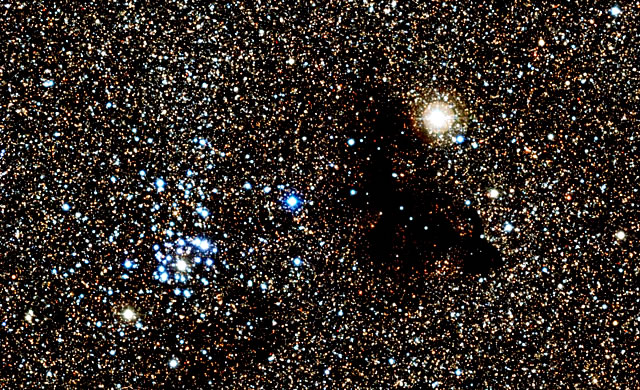
Questa immagine ottenuta con il WFI (Wide Field Imager) montato sul telescopio da 2,2 metri dell’MPG/ESO all’Osservatorio dell’ESO di La Silla, in Cile, mostra il luminoso ammasso stellare NGC 6520 e il suo vicino, la strana nube oscura, a forma di geco, nota come Barnard 86. Questo duo cosmico si staglia su un sfondo di milioni di stelle incandescenti della zona più luminosa della Via Lattea – una regione così densa di stelle che quasi non si vede un pezzetto di cielo libero, in questa fotografia.
uesta parte della costellazione del Sagittario è uno dei campi stellari più ricchi dell’intero cielo – la Grande Nube Stellare del Sagittario. L’enorme numero di stelle che illuminano questa regione enfatizza l’oscurità di nubi oscure come Barnard 86, che si vede al centro di questa nuova immagine ottenuta dal WFI (Wide Field Imager), uno strumento montato sul telescopio da 2,2 metri dell’MPG/ESO all’Osservatorio dell’ESO di La Silla, in Cile.
Fonte/Leggi tutto → ESO.org
This image from the Wide Field Imager on the MPG/ESO 2.2-metre telescope at ESO’s La Silla Observatory in Chile, shows the bright star cluster NGC 6520 and its neighbour, the strange gecko-shaped dark cloud Barnard 86. This cosmic pair is set against millions of glowing stars from the brightest part of the Milky Way — a region so dense with stars that barely any dark sky is seen across the picture.
This part of the constellation of Sagittarius (The Archer) is one of the richest star fields in the whole sky — the Large Sagittarius Star Cloud. The huge number of stars that light up this region dramatically emphasise the blackness of dark clouds like Barnard 86, which appears at the centre of this new picture from the Wide Field Imager, an instrument mounted on the MPG/ESO 2.2-metre telescope at ESO’s La Silla Observatory in Chile.
Source/Continue reading → ESO.org





















